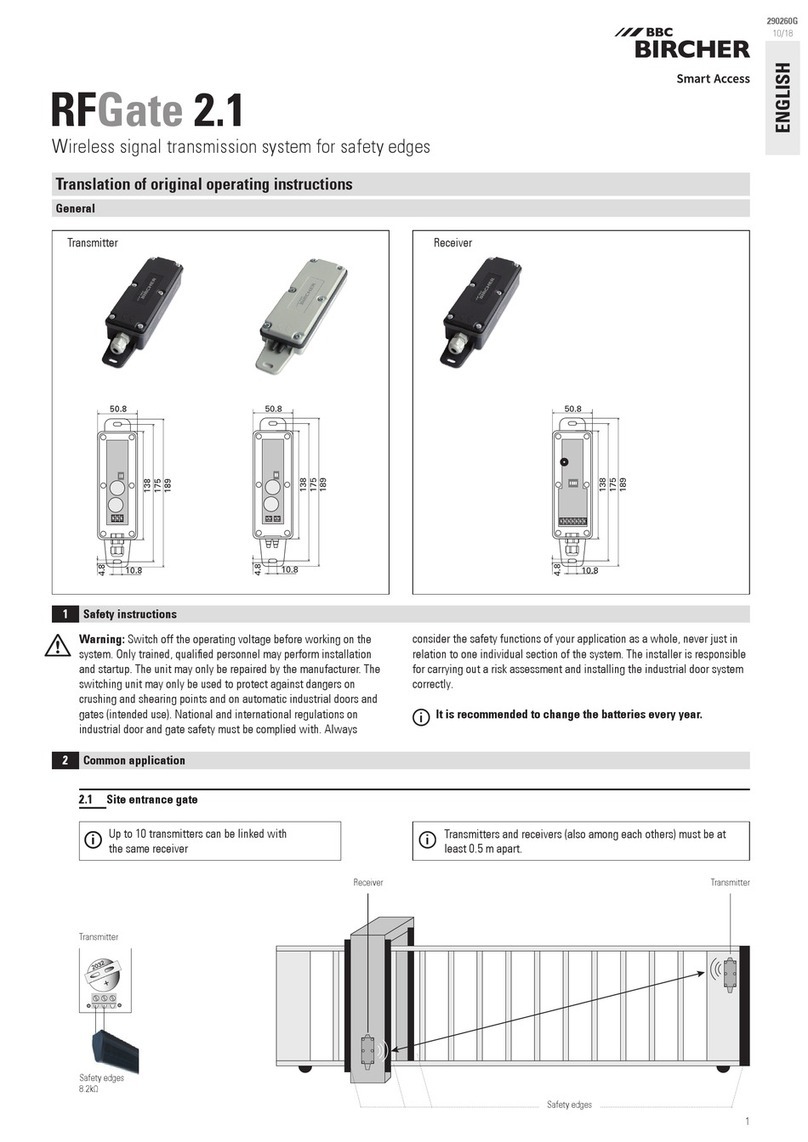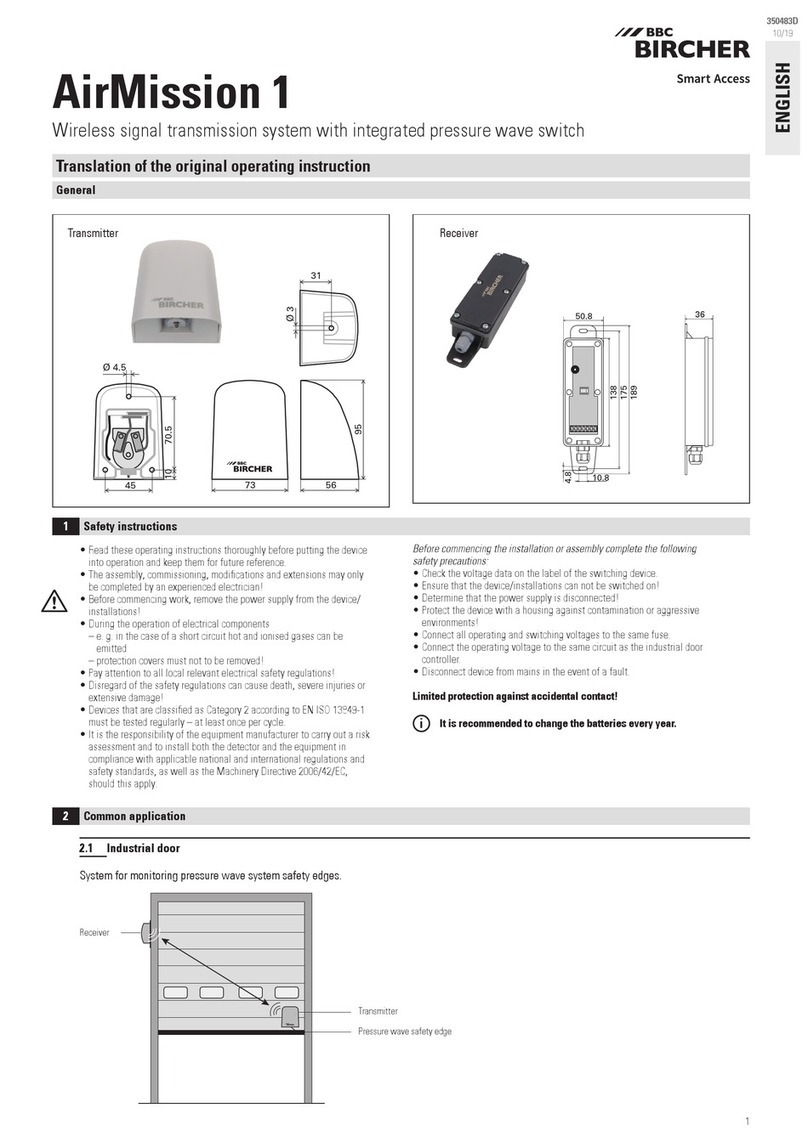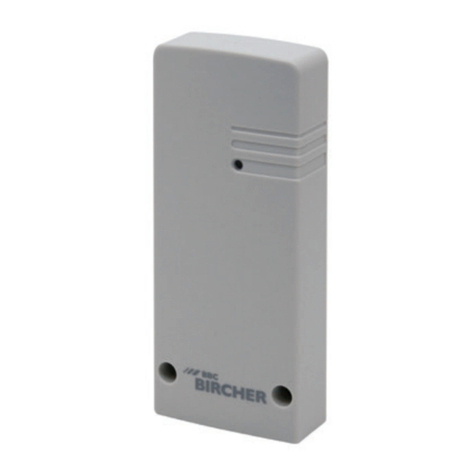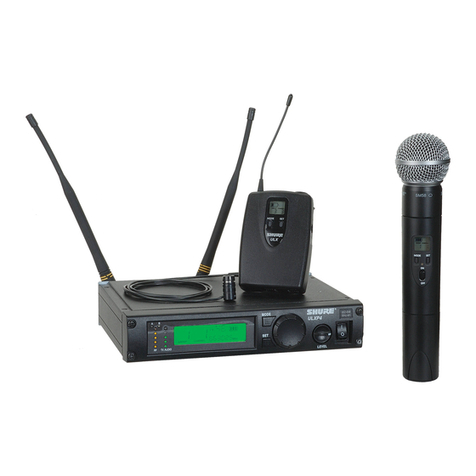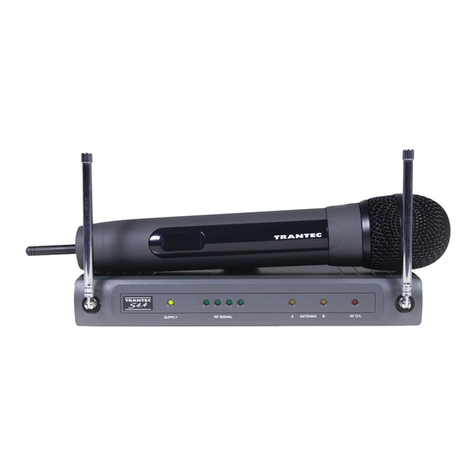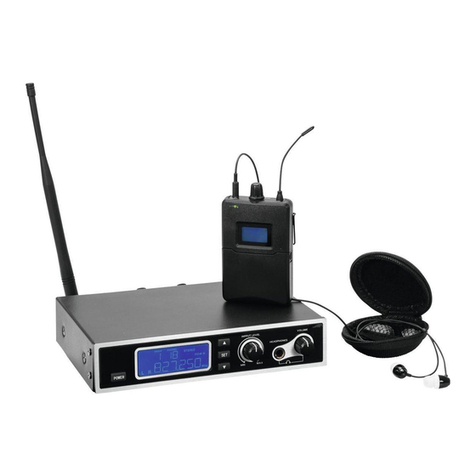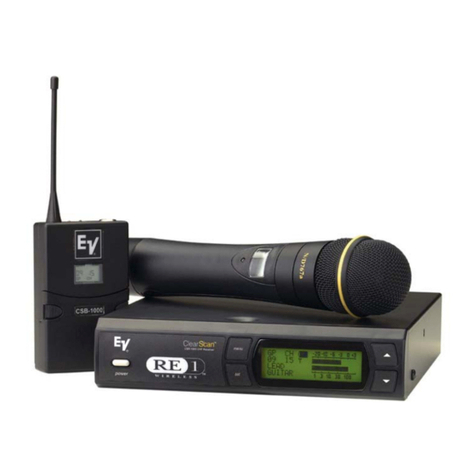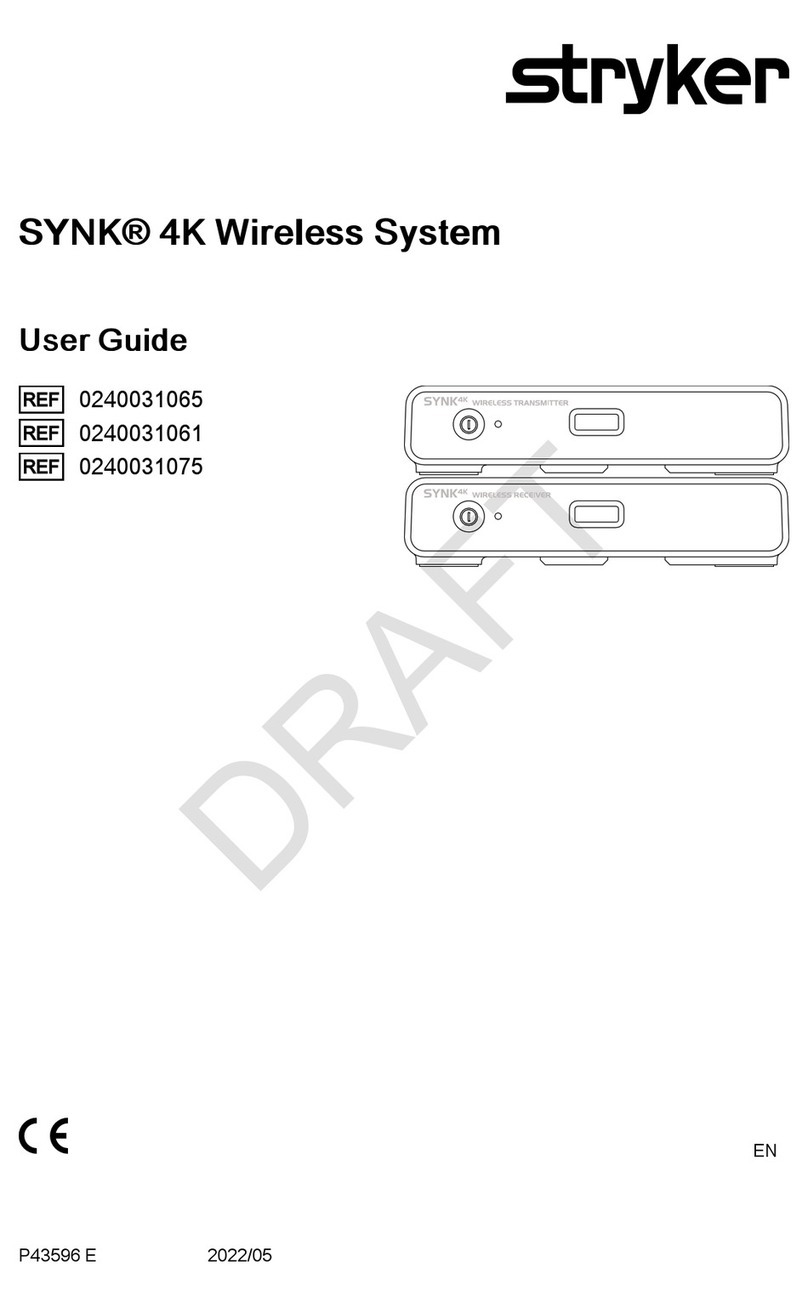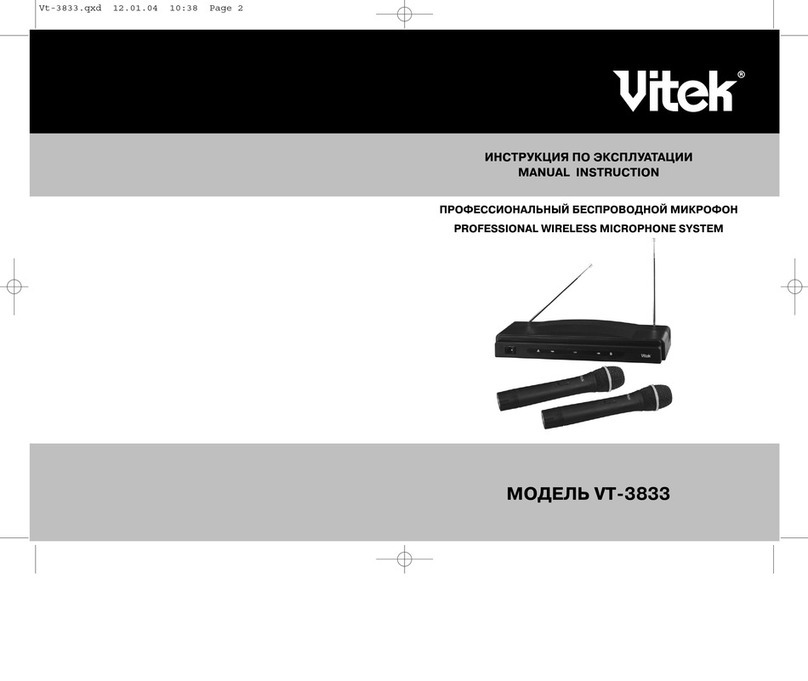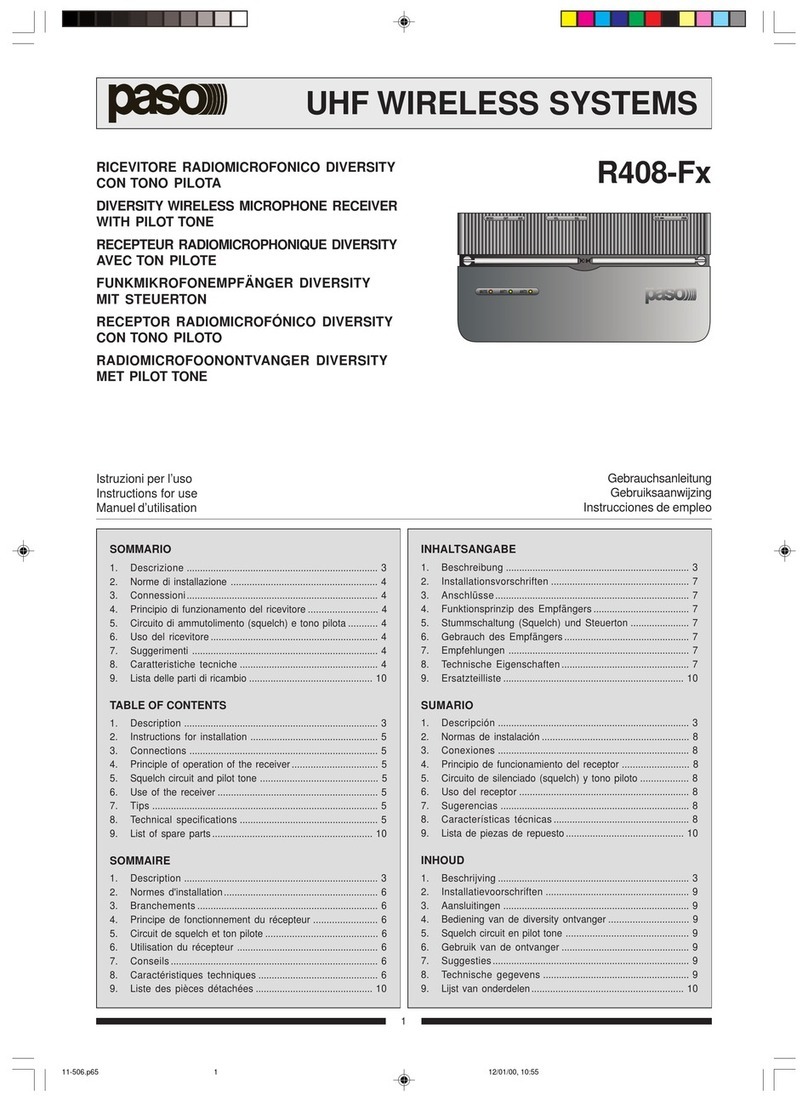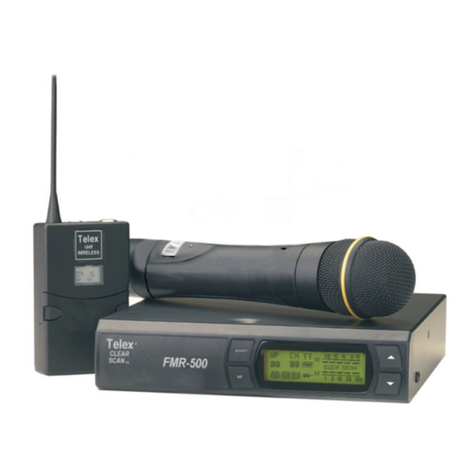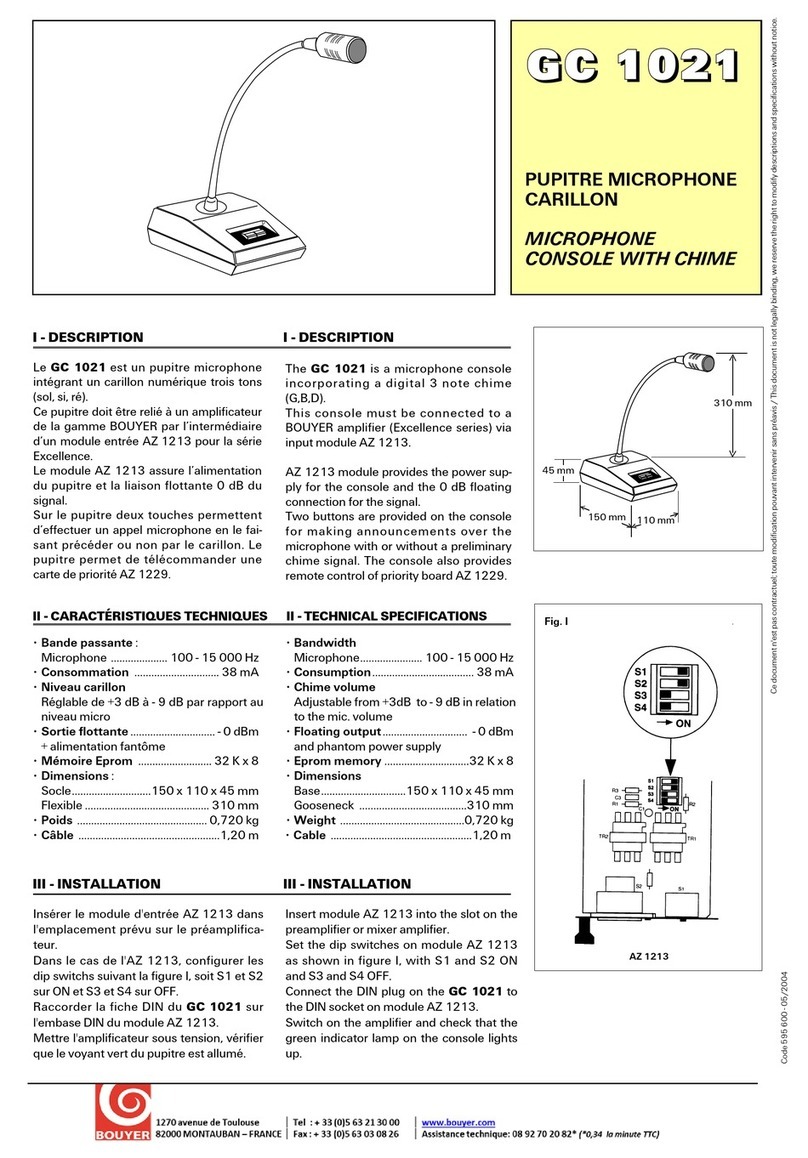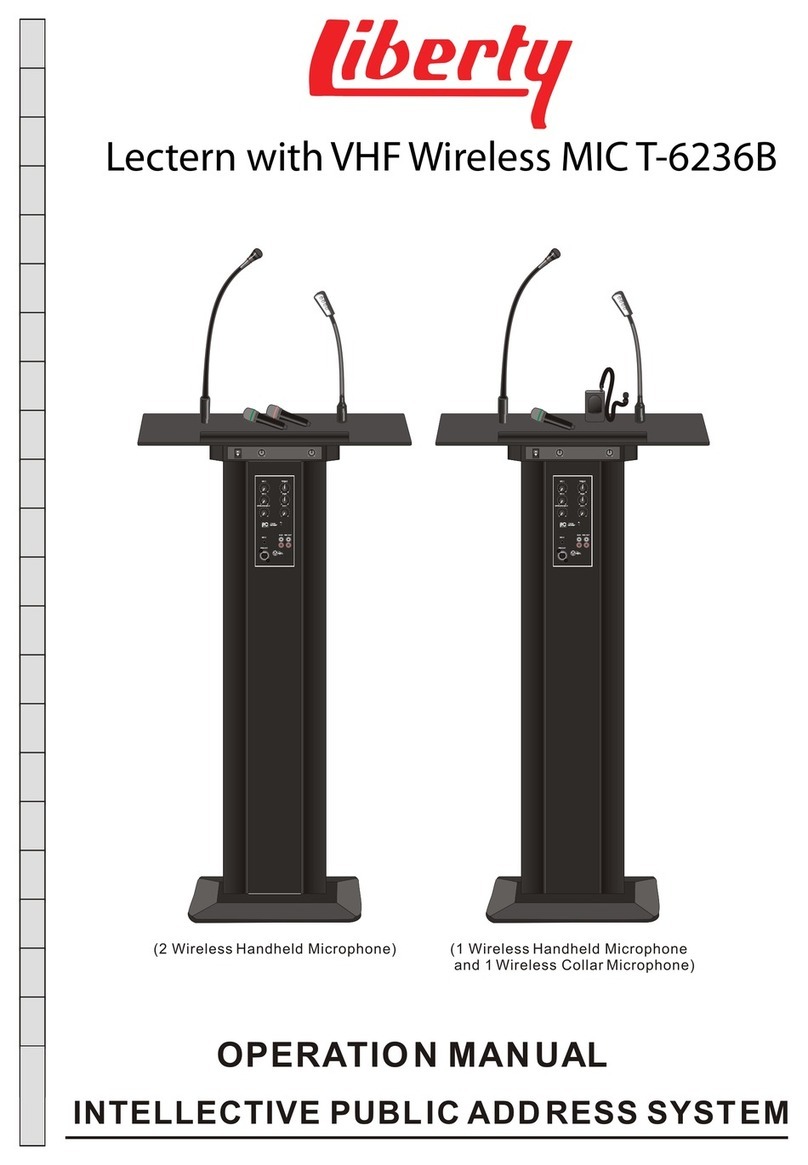BBC Bircher RFGate 2.2.W2.F.A Quick guide

1
12 3 4 5
ON
+
2032
23
175
189
50.8
138
10.8
4.8
80 45
121
162
178
RFGate 2.2.W2.F.A
14
4.3
57.6
1 7. 0
15.5
65.7
Wireless signal transmission system for safety edges, two channels
Translation of the original operating instructions
General
1Safety instructions
2Common application
2.1 Industrial door with wicket door
ENGLISH
349284E
01/19
Transmitter 1
DIP switch 5 ON
i
Transmitter 1 Transmitter 2 Receiver
Receiver
Safety edges
8.2 kΩ
Transmitter 1 input 1 corresponds to receiver output 1
Transmitter 2 corresponds to receiver output 2
Magnet
Transmitter 2
Drilling template enclosed
Warning: Switch off the operating voltage before working on the
system. Only trained, qualied personnel may perform installation
and startup. The unit may only be repaired by the manufacturer. The
switching unit may only be used to protect against dangers on
crushing and shearing points and on automatic industrial doors and
gates (intended use). National and international regulations on
industrial door and gate safety must be complied with. Always
consider the safety functions of your application as a whole, never just in
relation to one individual section of the system. The installer is responsible
for carrying out a risk assessment and installing the industrial door system
correctly.
It is recommended to change the batteries every year.
i

2
8K2
1 2
ON
IN1
IN2 2)
1 2
ON
IN1
IN2 2)
1)
8K28K2 8K28K2
2
ON
1 2
+
+
2032
2032
1
ON
1 2
+
2032
NC 2x
i
NC
NO 5x
+/~ –/~
12/24V
AC/DC
VCC1
VCC2
COM1
OUT1
SOUT1
COM2
OUT2
SOUT2
TST1
COM.T1
TST2
COM.T2
COM1
OUT1
COM2
OUT2
COM1
SOUT1
COM2
SOUT2
COM1
OUT1
COM2
OUT2
DIP switch Sensor connection DIP switch Sensor connection
1) Change from NC to NO, see chapter 3.2
2)
i
IN2 without function
Relay contacts are shown unpowered
3.2 Changing input from NC to NO (factory setting = NC)
4.2 Wiring: Outputs and control
4.3 DIP switches
3.1 DIP switch setting according to sensor (safety edge, switching contact)
4Receiver
3Transmitter 1
Gate control
with NC input
Gate control
8.2 kOhm input
Gate control with
NO input
Remove jumper(s)
4.1 Wiring: Power supply and test inputs
1 2 3 4 5
ON *Safety application
Standard
according to EN ISO 13849-1
1 2 3 4 5
ON Inactive ➔ no safety function
(Radio connection is not monitored)
12 3 4 5
ON Transmission frequency
869.85 MHz:
Set DIP-switch before pairing transmitter –
receiver
12 3 4 5
ON *868.95 MHz:
Set DIP-switch before pairing transmitter –
receiver
12 34 5
ON Test input type
NC
activated = contact open
12 34 5
ON *NO
activated = contact closed
12 3 45
ON Automatic frequency adjustment
Active
Used only in case of severe radio disturbance
12 3 45
ON *Inactive
12 3 4 5
ON *Programming (2 transmitters)
Transmitter 1 corresponds to output 1
Transmitter 2 corresponds to output 2
12 3 4 5
ON Programming (for 2 channel transmitter)
Not for this application
*= factory setting
RFGate 2.2.S.F
1.
Insert
battery 1
4.
Insert
battery 2
2.
Status
3.
Change
5.
Change
concluded
Press button on
transmitter Status changes LED ashes
LED ashes 2x LED ashes 5x
> 1.5 sec.
After inserting battery 1, you have
10 seconds to change the status
Observe the
sequence
NO
i
Transmitter 2 is xed to NC
Test
Common

3
ON
1 2
+
+
2032
2032
2
1
ON
1 2
+
2032
1 2
ON
1 2 3 4 5
ON
i
i
ON
12 3 4 5
ON
2x
2x
OK?
OK?
< 5 mm
+
3V
LITHIUM
CR 2032
+
3V
LITHIUM
CR 2032
+
3V
LITHIUM
CR 2032
+
3V
LITHIUM
CR 2032
+
6.1 Pairing the transmitter with the receiver
5Set-up
6Programming
2.
On the trans-
mitter 1 for
channel 1
On the receiver
On the receiver
Press and
release button
Beep Wait 2 beeps
10 sec.
4.
On the trans-
mitter 2 for
channel 2
Press and
release button
Beep Wait
10 sec.
3.
On the receiver
Beep BeepRelease button Release buttonLED
lights up
LED ashesPress button
> 1.5 sec.
Press
button
> 1.5 sec.
1.
On the receiver
BeepPress button
> 1.5 sec.
LED lights up
7.
Transmitter 1:
mount
Release button
4.
Transmitter 1:
insert
batteries
5.
Transmitter 2:
insert
batteries
Please observe the torque when
fastening the cover:
Max. 45 N cm
1.
Check DIP switch
settings
6.
Programming (Chapter 6.1):
pair transmitter with receiver
The distance between the trans-
mitter and receiver and additional
transmitters must be at least 1 m
2 beeps
Observe
order
Code saved
LED goes out
Code saved
LED goes out
8.
Transmitter 1:
wire
3.
Receiver:
Turn on power
supply
2.
Receiver: Install
and wire
11.
System test:
safety edge on gate
see 7.1
Beep
Beep
BeepBeep
BeepBeep
Beep
9.
Mount trans-
mitter 2 and
the magnet
10.
Note: Distance between
magnet / transmitter when
doors are closed
12.
System test wicket door:
opening and closing
see 7.1
Transmitter 1:
Transmitter 2:
Wicket
door
correctly
positioned
Status Terminals
COMx – OUTx
Terminals
COMx – SOUTx
Sensor not activated (operating mode) 8K2 closed
Sensor activated (security system activated) closed open
No supply voltage closed open
Transmitter and receiver not paired closed open
Broken cable between sensor and transmitter closed open
Transmitter batteries low closed open

4
12345
ON SAB
SELECT
REL 1 REL21
R2R1
1 2
12345
ON SAB
SELECT
REL 1 REL21
R2R1
1 2
2x
4x
3V
LITHIUM
CR 2032
+
3V
LITHIUM
CR 2032
+
3V
LITHIUM
CR 2032
+
3V
LITHIUM
CR 2032
+
Designed in Switzerland / Made in EU
BBC Bircher Smart Access, BBC Bircher AG, Wiesengasse 20, CH-8222 Beringen, www.bircher.com
7Standard operation
9Technical data
7.1 Receiver LED indicators
7.2 Warning indicator for low battery voltage
Object
detected
LED off
Wicket doors
open
LED off
LED 1 LED 2
Signal emitted with each activation of the transmitter
Receiver
Supply voltage 12/24 V ACDC
Transmitter memory 7 + 7
Output 2 relays 24 V, 0.5 A; micro switch-off 1B
Power consumption 0.5 W @ 12 V; 1.2 W @ 24 V
Test signal input 12/24 VACDC
Protection class IEC 60529 IP55
Transmitter 1
Battery power 2 x Lithium 3 V type CR2032
Power consumption Transmitting: 17 mA standby: 16 µA
Protection class IEC 60529 IP55
Safety OK Wicket doors
closed
LED on LED on
Battery voltage
low
System
Frequency bands 868.95 MHz & 869.85 MHz
Range Under optimum conditions up to 100 m
Pollution degree 2
Working temperature -20 °C to +55 °C
Transmitter 2
Battery power 2 x Lithium 3 V type CR2032
Power consumption Transmitting: 17 mA standby: 16 µA
Protection class IEC 60529 IP65
6.2 Transmitter reset (Deletion of transmitter-receiver pairing)
6.3 Memory full
Press button Hold down button Short beepsBeep WaitRelease button
10 sec.
> 1.5 sec. > 3 sec.
2 beeps
On the receiver Memory cleared
on all trans-
mitters
BeepBeep Beep BeepBeep
Beep
Beep 10 sec.
8Alternative installation with double sided tape (not supplied)
Caution!
Ensure surfaces are clean, dry and free of dust and grease.
View of transmitter 2
(bottom) Double-sided
adhesive tape
6.4 Battery change
10 EU Declaration of Conformity
12 Contact
See attachment
11 WEEE
Devices with this symbol must be treated separately during
disposal. This must be done in accordance with the laws of
the respective countries for environmentally sound disposal,
processing and recycling of electrical and electronic equip-
ment.
Other BBC Bircher Microphone System manuals
